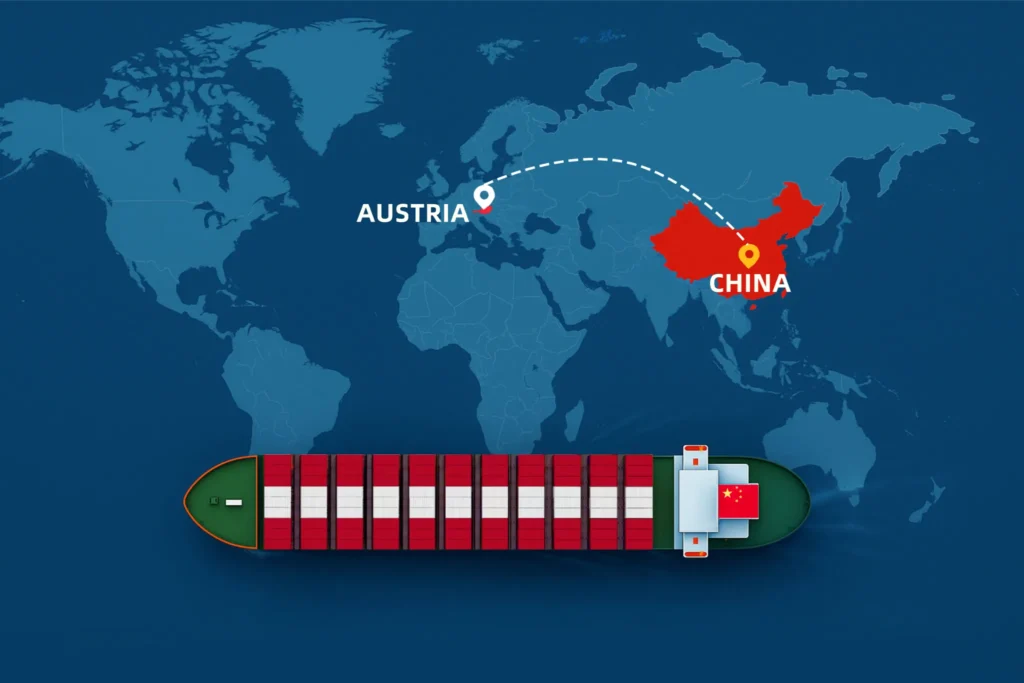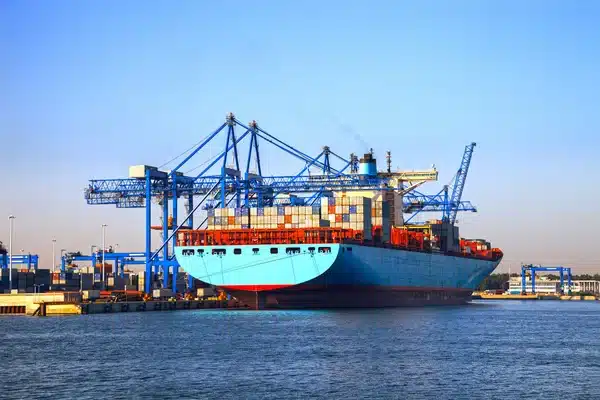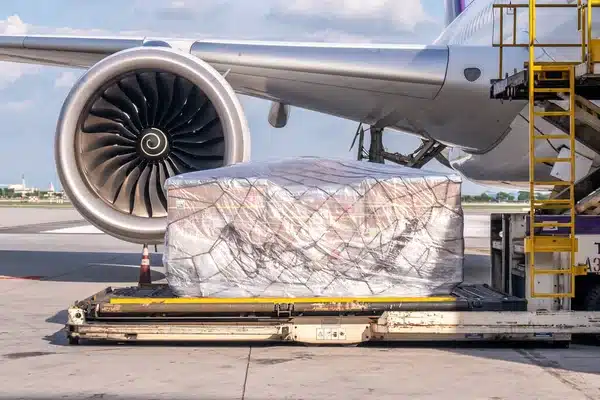AUSTRIA
ONE-STOP GLOBALLOGISTICS PROVIDER
SHIPPING FROM CHINA TO AUSTRIA
Austria, a strategically located country in Central Europe, shares borders with the Czech Republic, Germany, Slovakia, Hungary, Slovenia, Italy, and Switzerland. In 2023, the trade volume between China and Austria reached 25.7 billion euros, with major exports including machinery, electronics, automotive parts, and textiles.
Tonlexing offers two primary modes of transportation from China to Austria:
• Air Freight: Fast and reliable for urgent shipments, ideal for high-value or time-sensitive goods.
• Sea Freight: Cost-effective for large volumes, suitable for bulk commodities and non-perishable goods.
Tonlexing is here to answer all your questions and ensure smooth and efficient shipping from China to Austria.

Table of Contents
Shipping from China to Austria: Comprehensive Guide for Sea Freight and Air Freight
Shipping goods from China to Austria has become increasingly efficient and accessible, thanks to well-established trade routes and reliable logistics networks. Whether you are shipping electronics, machinery, furniture, or fashion products, choosing the right method—sea freight or air freight—is essential for balancing cost, speed, and convenience.
For businesses shipping large or bulky cargo, sea freight offers the most cost-effective solution, with regular departures from major Chinese ports to Austrian hubs via European entry ports. On the other hand, air freight is ideal for urgent or high-value shipments, ensuring quick delivery to Austria’s primary airports, such as Vienna International Airport.
With a combination of advanced logistics solutions, customs clearance services, and various shipping options, businesses and individuals can easily transport goods from China to Austria. This guide will explore shipping times, costs, major ports and airports, and essential steps to streamline your logistics process.
Sea Freight from China to Austria
Sea freight is the most economical choice for transporting large volumes of goods from China to Austria. Whether you’re shipping industrial machinery, textiles, furniture, or consumer goods, sea freight offers unmatched cost-efficiency for businesses with less urgent delivery needs.
Although sea freight has longer transit times compared to air freight, it remains the preferred solution for bulk shipments and heavy cargo due to its affordability. Partnering with experienced freight forwarders ensures seamless coordination of transport, customs clearance, and delivery to Austrian cities like Vienna, Graz, and Linz.
This section will cover transit times, shipping costs, and the step-by-step process for sea freight from China to Austria, helping you make informed logistics decisions for your business.

Major Ports for Sea Freight from China to Austria
When shipping goods from China to Austria via sea freight, the cargo typically transits through key European ports before being transported inland to Austria by road or rail. Below are the major departure ports in China and the primary arrival ports in Europe that serve as gateways to Austria:
Main Departure Ports in China
- Shanghai Port – The largest and busiest port in China, offering regular sailings and efficient handling for bulk and containerized goods.
- Shenzhen Port – A major hub in southern China, ideal for electronics, machinery, and consumer goods.
- Ningbo-Zhoushan Port – Known for its high efficiency and cost-effective shipping services, particularly for large volumes.
- Guangzhou Port – A key port in southern China with competitive rates for sea freight to Europe.
- Qingdao Port – A vital port in northern China, suitable for exporting heavy and industrial goods.
Main Arrival Ports Serving Austria
- Port of Hamburg (Germany) – The most popular choice for shipments to Austria due to its proximity and well-established rail and road connections.
- Port of Koper (Slovenia) – An efficient gateway for sea freight to Central Europe, offering a shorter transit route for goods heading to Austria.
- Port of Rotterdam (Netherlands) – Europe’s largest port, serving as a key hub for goods transshipped to Austria.
- Port of Trieste (Italy) – Located close to Austria, Trieste provides a strategic entry point for shipments requiring swift inland delivery.
- Port of Antwerp (Belgium) – Another major European hub with reliable connections to Austria via rail and road freight.
Key Notes
- Cargo arriving at these ports is typically transported to Austria using rail freight or trucking services to cities such as Vienna, Graz, and Linz.
- The choice of port depends on factors like transit time, cost, and the proximity of the final delivery location.
By selecting the most suitable ports, businesses can optimize costs and ensure timely delivery of their sea freight shipments from China to Austria.
How Long Does Sea Freight from China to Austria Take?
Sea freight from China to Austria involves shipping goods to major European ports, followed by inland transportation via rail or road freight. The total transit time depends on the departure port in China, the arrival port in Europe, and the inland delivery process to Austria.
Estimated Transit Times by Route
| Departure Port (China) | Arrival Port (Europe) | Estimated Transit Time |
|---|---|---|
| Shanghai Port | Hamburg, Germany | 28-32 days |
| Shenzhen Port | Rotterdam, Netherlands | 30-35 days |
| Ningbo-Zhoushan Port | Koper, Slovenia | 25-30 days |
| Guangzhou Port | Trieste, Italy | 27-32 days |
| Qingdao Port | Hamburg, Germany | 29-34 days |
Inland Transit to Austria
After arrival at a European port, goods are transported to Austria by rail or road:
- Rail Freight: Takes an additional 2-5 days to reach key Austrian cities like Vienna, Linz, or Graz.
- Road Freight: Typically takes 1-3 days for shorter distances from nearby ports like Hamburg, Koper, or Trieste.
How Much Does Sea Freight from China to Austria Cost?
Sea freight costs from China to Austria depend on factors such as container type, shipment size, departure ports, and arrival hubs in Europe. Below are estimated costs for shipping Full Container Load (FCL) and Less than Container Load (LCL) cargo:
Estimated Sea Freight Costs
| Departure Port (China) | Arrival Port (Europe) | 20FT Container (USD) | 40FT Container (USD) | LCL Cost (USD/CBM) |
|---|---|---|---|---|
| Shanghai Port | Hamburg, Germany | $1,150 – $1,350 | $1,700 – $2,050 | $65 – $90 |
| Shenzhen Port | Rotterdam, Netherlands | $1,200 – $1,400 | $1,750 – $2,100 | $70 – $95 |
| Ningbo-Zhoushan Port | Koper, Slovenia | $1,050 – $1,250 | $1,600 – $1,950 | $60 – $85 |
| Guangzhou Port | Trieste, Italy | $1,100 – $1,300 | $1,650 – $2,000 | $65 – $90 |
| Qingdao Port | Hamburg, Germany | $1,150 – $1,350 | $1,700 – $2,050 | $65 – $90 |
For the most accurate and competitive rates tailored to your shipment, contact us today. We provide seamless sea freight solutions from China to Austria at affordable prices!
Sea Freight Process from China to Austria
1. Cargo Preparation
- Goods are securely packaged to meet international shipping standards.
- Export documents, including the commercial invoice, packing list, and bill of lading (BOL), are prepared.
- Accurate weight and dimensions of the cargo are recorded to determine container size (20FT, 40FT, or LCL).
2. Booking and Space Reservation
- A reliable freight forwarder reserves space on the vessel departing from a major Chinese port (e.g., Shanghai, Shenzhen, Ningbo).
- The shipping schedule and estimated arrival time are confirmed with the carrier.
3. Transport to the Port of Departure
- Goods are transported via truck or rail from the supplier’s location to the designated departure port.
- At the port, cargo is processed for loading into containers (FCL) or consolidated (LCL).
4. Export Customs Clearance
- Export documentation is submitted to Chinese customs authorities for approval.
- Customs checks the cargo for compliance with export regulations.
- Once approved, the goods receive clearance and are loaded onto the vessel.
5. Sea Transit
- The container is shipped to a European entry port, such as Hamburg (Germany), Koper (Slovenia), or Trieste (Italy).
- Average sea transit time: 25-35 days depending on the route and port selection.
6. Arrival at the Destination Port
- The container is unloaded and moved to the customs clearance area at the arrival port.
- Import documentation is verified, and duties/taxes are assessed by the local customs authorities.
7. Import Customs Clearance
- Documents such as the commercial invoice, packing list, and bill of lading are submitted for clearance.
- Customs duties and VAT are paid based on the shipment’s CIF value (Cost, Insurance, and Freight).
- The cargo is released for inland transportation.
8. Inland Transport to Austria
- Goods are transported from the European port to Austria via rail freight or road freight.
- Final delivery is made to the consignee’s address in key cities like Vienna, Graz, or Linz.
Air Freight from China to Austria
Air freight is the ideal choice for businesses and individuals needing to transport time-sensitive, high-value, or lightweight goods from China to Austria. Whether you’re shipping electronics, medical equipment, fashion products, or perishable items, air freight ensures fast and reliable delivery with shorter transit times compared to sea freight.
Although air freight comes at a higher cost, its speed, security, and efficiency make it the preferred option for urgent deliveries or goods requiring special handling. By working with experienced freight forwarders, you can streamline the process, from booking cargo space to managing customs clearance and final delivery.
In this section, we’ll explore transit times, shipping costs, and the operational process of air freight from China to Austria, providing you with the insights needed for efficient shipping solutions.

Major Airports for Air Freight from China to Austria
When shipping cargo via air freight from China to Austria, goods are transported through key international airports in both countries. Below are the main departure and arrival airports that facilitate air freight between China and Austria:
Main Departure Airports in China
- Shanghai Pudong International Airport (PVG)
- China’s largest air cargo hub, offering frequent direct and indirect flights to Europe.
- Guangzhou Baiyun International Airport (CAN)
- A major airport in southern China, ideal for shipping electronics, textiles, and machinery.
- Shenzhen Bao’an International Airport (SZX)
- Known for handling high-value and time-sensitive goods.
- Beijing Capital International Airport (PEK)
- A critical hub for air freight from northern China to Europe.
- Hong Kong International Airport (HKG)
- One of the busiest air cargo hubs in the world, offering extensive global connections.
Main Arrival Airport in Austria
Vienna International Airport (VIE)
- Located near the Austrian capital, Vienna International Airport serves as the primary air cargo hub for imports into Austria.
- The airport features efficient customs clearance and direct connections to other parts of Austria and Europe via road and rail.
How Long Does Air Freight from China to Austria Take?
The transit time for air freight from China to Austria depends on the departure airport, route, and whether the flight is direct or involves transshipment. Below is an estimate of the delivery times for key routes:
Estimated Air Freight Transit Times
| Departure Airport (China) | Arrival Airport (Austria) | Estimated Transit Time |
|---|---|---|
| Shanghai Pudong (PVG) | Vienna International (VIE) | 5-7 days |
| Guangzhou Baiyun (CAN) | Vienna International (VIE) | 6-8 days |
| Shenzhen Bao’an (SZX) | Vienna International (VIE) | 5-7 days |
| Beijing Capital (PEK) | Vienna International (VIE) | 6-8 days |
| Hong Kong International (HKG) | Vienna International (VIE) | 4-6 days |
Key Notes
Air freight from China to Austria typically takes an average of 5-7 days, making it the fastest and most reliable shipping method for time-sensitive cargo. Partnering with a professional freight forwarder ensures smooth operations, from booking cargo space to final delivery in Austria.
For tailored transit options and competitive pricing, contact us today!
How Much Does Air Freight from China to Austria Cost?
The cost of air freight from China to Austria depends on the cargo weight, volume, and flight route. Below are the estimated rates for shipments to Vienna International Airport (VIE), Austria’s primary cargo hub.
Estimated Air Freight Costs
| Departure Airport (China) | Arrival Airport (Austria) | Cost Per KG (USD) |
|---|---|---|
| Shanghai Pudong (PVG) | Vienna International (VIE) | $3.80 – $4.50 |
| Guangzhou Baiyun (CAN) | Vienna International (VIE) | $4.00 – $4.60 |
| Shenzhen Bao’an (SZX) | Vienna International (VIE) | $3.90 – $4.40 |
| Beijing Capital (PEK) | Vienna International (VIE) | $4.10 – $4.70 |
| Hong Kong International (HKG) | Vienna International (VIE) | $3.70 – $4.20 |
For precise air freight quotes tailored to your shipment size and requirements, contact us today. We offer competitive rates and comprehensive solutions to streamline your shipping from China to Austria!
Air Freight Process from China to Austria
1. Cargo Preparation
- The shipper prepares the goods, ensuring proper packaging to meet international air freight standards.
- Goods are measured, weighed, and labeled for accurate documentation.
- Essential documents such as the Commercial Invoice, Packing List, and Air Waybill (AWB) are prepared.
2. Booking and Space Reservation
- A freight forwarder books cargo space with airlines departing from key Chinese airports (e.g., Shanghai Pudong, Guangzhou Baiyun, or Hong Kong International).
- Flight schedules, transit times, and rates are confirmed to align with delivery requirements.
3. Transport to the Airport of Departure
- Goods are transported from the supplier’s location to the departure airport via truck or other local logistics providers.
- The cargo undergoes cargo screening and pre-flight checks to meet safety and airline requirements.
4. Export Customs Clearance in China
- Export documentation, including the commercial invoice and packing list, is submitted to Chinese customs for approval.
- Customs authorities inspect the goods to verify compliance with export regulations.
- Once approved, the cargo is cleared for shipment and loaded onto the aircraft.
5. Air Freight Transit
- The cargo is flown from the departure airport in China to Vienna International Airport (VIE) in Austria.
- Direct flights typically take 5-7 days, while transshipment flights may extend the transit time slightly.
6. Import Customs Clearance in Austria
- Upon arrival at Vienna International Airport, the cargo is unloaded and inspected by Austrian customs authorities.
- Import duties, VAT, and other fees are assessed based on the CIF value (Cost, Insurance, and Freight) of the shipment.
- Required documents include:
- Air Waybill (AWB)
- Commercial Invoice
- Packing List
- Certificate of Origin (if applicable)
7. Final Delivery
- After customs clearance, the cargo is handed over to local transport providers for last-mile delivery to the consignee’s location.
- Goods are transported via truck to cities like Vienna, Graz, Linz, or other destinations across Austria.
Customs Clearance and Duties for Shipping from China to Austria
When shipping goods from China to Austria, understanding the customs clearance process and associated duties is essential to ensure smooth delivery. Austria, as part of the European Union (EU), follows standardized customs regulations and VAT policies.

Customs Clearance Process
Document Preparation
- Ensure all necessary shipping documents are ready:
- Commercial Invoice (including detailed product descriptions and value)
- Packing List
- Bill of Lading (BOL) or Air Waybill (AWB)
- Certificate of Origin (if applicable)
- HS Codes for all items being shipped.
- Ensure all necessary shipping documents are ready:
Submission to Customs Authorities
- Upon arrival in Austria, the documents are submitted to Austrian customs for clearance.
- Customs will verify the shipment’s declared value, classification, and compliance with EU regulations.
Customs Inspection
- Cargo may undergo physical inspection, especially for high-risk items, restricted goods, or missing/incomplete documentation.
Duties and Taxes Assessment
- Import duties and Value Added Tax (VAT) are calculated based on the CIF value (Cost, Insurance, and Freight) of the goods.
Payment of Duties and Taxes
- Importers or their freight forwarders must settle all assessed duties and taxes to release the goods.
Cargo Release
- Once cleared, the shipment is released for final delivery to the consignee’s location in Austria.
Customs Duties and VAT
| Type of Charge | Description |
|---|---|
| Import Duties | Vary based on the HS code and product type. Typical rates range between 0% and 12%. |
| Value Added Tax (VAT) | Austria applies a standard VAT rate of 20% on the total CIF value, including duties. |
| Anti-Dumping Duties (if any) | May apply to specific products such as steel or textiles. |
Example of Duty Calculation
Suppose you are importing electronics worth $10,000 with a shipping cost of $500 and insurance of $100:
- CIF Value = $10,000 + $500 + $100 = $10,600
- Import Duty (e.g., 5%) = $10,600 × 5% = $530
- VAT (20%) = ($10,600 + $530) × 20% = $2,226
- Total Duties and Taxes = $530 + $2,226 = $2,756
Tips for Smooth Customs Clearance
- Use correct HS codes to avoid overpaying duties or delays.
- Work with an experienced freight forwarder or customs broker.
- Ensure documents are accurate and complete to prevent customs holds.
- Plan for duties and VAT in advance to avoid unexpected charges.
By understanding Austria’s customs clearance process and tax structure, you can streamline your shipping operations and avoid delays. For expert assistance in handling customs and ensuring compliance, contact us today!
Why Choose Us for Your China to Austria Shipping Needs?
At Tonlexing, we specialize in providing seamless and cost-effective shipping solutions tailored to your business needs. Whether you’re shipping via sea freight, air freight, or need comprehensive door-to-door services, we ensure your cargo arrives safely and on time.
✅ Competitive Rates: Affordable solutions for businesses of all sizes.
✅ Reliable Services: On-time delivery with real-time tracking updates.
✅ Customs Expertise: Hassle-free clearance with professional support.
✅ Flexible Options: FCL, LCL, express shipping, and DDP options available.
Let us simplify your logistics! Contact us today for a personalized shipping quote and expert support for your China to Austria shipments. Your cargo is our priority.
Shipping from China to Austria: Frequently Asked Questions (FAQs)
The primary shipping methods include:
- Sea Freight: Cost-effective for bulk and heavy cargo.
- Air Freight: Fastest option for time-sensitive or high-value goods.
- Rail Freight: A balance between cost and transit time.
- Door-to-Door Services: Convenient, all-inclusive shipping solutions.
- Sea Freight: 25-35 days, depending on the route and port of entry.
- Air Freight: 5-7 days for direct flights.
- Rail Freight: 18-25 days via China-Europe rail routes.
- Door-to-Door: Varies based on the chosen method (sea, air, or rail).
- Commercial Invoice
- Packing List
- Bill of Lading (BOL) or Air Waybill (AWB)
- Certificate of Origin (if applicable)
- HS Codes for goods classification
Yes, all shipments can be tracked using a tracking number provided by the freight forwarder or shipping company.
Major cities like Vienna, Graz, Linz, Salzburg, and Innsbruck are accessible via inland transportation (road or rail) after arriving at European ports or Vienna International Airport.


